Projection of the Climate-Suitable Area of the Invasive Pest Phoracantha semipunctata (Coleoptera: Cerambycidae: Phoracantha) and Its Ability to Continue to Expand in China
Simple Summary
Abstract
1. Introduction
2. Materials and Methods
2.1. Presence Records of P. semipunctata
2.2. Environmental Data
2.3. P. semipunctata Distribution Predicted by RF
3. Results
3.1. Bioclimatic Profile of P. semipunctata
3.2. Filtering of Important Environmental Variables and Model Performance
3.3. Potential Distribution of P. semipunctata in China from the Current to the Future
3.3.1. Potential Distribution of P. semipunctata in the Current Climate Scenario
3.3.2. Potential Distribution of P. semipunctata Under Future Climate Scenarios
4. Discussion
5. Conclusions
Author Contributions
Funding
Data Availability Statement
Acknowledgments
Conflicts of Interest
Abbreviations
| P. semipunctata | Phoracantha semipunctata |
| RF | Random Forests |
References
- Zhang, Y.; Wang, X. Geographical spatial distribution and productivity dynamic change of eucalyptus plantations in China. Sci. Rep. 2021, 11, 19764. [Google Scholar] [CrossRef]
- Mengistu, B.; Amayu, F.; Bekele, W.; Dibaba, Z. Effects of Eucalyptus species plantations and crop land on selected soil properties. Geol. Ecol. Landsc. 2022, 6, 277–285. [Google Scholar] [CrossRef]
- Ouyang, L.; Arnold, R.L.; Chen, S.; Xie, Y.; He, S.; Liu, X.; Zhang, W. Prediction of the suitable distribution of Eucalyptus grandis in China and its responses to climate change. New. For. 2022, 53, 81–99. [Google Scholar] [CrossRef]
- Adame, P.; Alberdi, I.; Canellas, I.; Hernandez, L.; Aguirre, A.; Ruano, A.; Moreno-Fernandez, D.; Gonzalez, A.I.; Torres, M.B.; Montes, F. Drivers and spread of non-native pests in forests: The case of Gonipterus platensis in Spanish Eucalyptus plantations. For. Ecol. Manag. 2022, 510, 120104. [Google Scholar] [CrossRef]
- Gu, M.; Hong, F. Ecological control on insect pests of Eucalyptus. J. For. Res. 2006, 19, 316–320. [Google Scholar] [CrossRef]
- Linsley, E.G. Ecology of Cerambycidae. Annu. Rev. Entomol. 1959, 4, 99–138. [Google Scholar] [CrossRef]
- Li, T.; Zhang, L.; Huang, P. Alert of invasion of quarantine pest, Phoracantha semipunctata. J. Plant. Quar. 2021, 35, 71–73. [Google Scholar] [CrossRef]
- Li, T.; Zhang, L.; Huang, P. The list and geographic distribution of the genus Phoracantha in the world. For. Sci. Technol. 2021, 12, 52–55. [Google Scholar] [CrossRef]
- Haack, R.A. Feeding Biology of Cerambycids. In Cerambycidae of the World: Biology and Pest Management; Wang, Q., Ed.; CRC Press: Boca Raton, FL, USA, 2017; pp. 105–132. [Google Scholar]
- Hanks, L.M.; McElfresh, J.S.; Millar, J.G.; Paine, T.D. Phoracantha semipunctata (Coleoptera: Cerambycidae), a serious pest of Eucalyptus in California: Biology and laboratory-rearing procedures. Ann. Entomol. 1993, 86, 96–102. [Google Scholar] [CrossRef]
- IPCC. Climate Change 2014: Synthesis Report; Contribution of Working Groups I, II and III to the Fifth Assessment Report of the Intergovernmental Panel on Climate Change; IPCC: Geneva, Switzerland, 2014. [Google Scholar]
- Ni, J. Impacts of climate change on Chinese ecosystems: Key vulnerable regions and potential thresholds. Reg. Environ. Change 2011, 11, S49–S64. [Google Scholar] [CrossRef]
- Zeng, H.; Xiao, C.; Chen, X.; Chen, Y.; Ye, D. State of China’s climate in 2019. Atmospheric Ocean. Sci. Lett. 2020, 13, 356–362. [Google Scholar] [CrossRef]
- Regniere, J.; Powell, J.; Bentz, B.; Nealis, V. Effects of temperature on development, survival and reproduction of insects: Experimental design, data analysis and modeling. J. Insect. Physiol. 2012, 58, 634–647. [Google Scholar] [CrossRef]
- Skendzic, S.; Zovko, M.; Zivkovic, I.P.; Lesic, V.; Lemic, D. The Impact of Climate Change on Agricultural Insect Pests. Insects 2021, 12, 440. [Google Scholar] [CrossRef] [PubMed]
- Halsch, C.A.; Shapiro, A.M.; Fordyce, J.A.; Nice, C.C.; Thorne, J.H.; Waetjen, D.P.; Forister, M.L. Insects and recent climate change. Proc. Natl. Acad. Sci. USA 2021, 118, e2002543117. [Google Scholar] [CrossRef] [PubMed]
- Valavi, R.; Elith, J.; Lahoz-Monfort, J.J.; Guillera-Arroita, G. Modelling species presence-only data with random forests. Ecography 2021, 44, 1731–1742. [Google Scholar] [CrossRef]
- Sipper, M.; Moore, J.H. Conservation machine learning: A case study of random forests. Sci. Rep. 2021, 11, 3629. [Google Scholar] [CrossRef]
- Breiman, L. Random Forests. Mach. Learn. 2001, 45, 5–32. [Google Scholar] [CrossRef]
- Schonlau, M.; Zou, R.Y. The random forest algorithm for statistical learning. Stata. J. 2020, 20, 3–29. [Google Scholar] [CrossRef]
- Simon, S.M.; Glaum, P.; Valdovinos, F.S. Interpreting random forest analysis of ecological models to move from prediction to explanation. Sci. Rep. 2023, 13, 3881. [Google Scholar] [CrossRef]
- Chen, R.; Dewi, C.; Huang, S.; Caraka, R.E. Selecting critical features for data classification based on machine learning methods. J. Big. Data 2020, 7, 52. [Google Scholar] [CrossRef]
- Guralnick, R.P.; Campbell, L.P.; Belitz, M.W. Weather anomalies more important than climate means in driving insect phenology. Commun. Biol. 2023, 6, 490. [Google Scholar] [CrossRef] [PubMed]
- Subedi, B.; Poudel, A.; Aryal, S. The impact of climate change on insect pest biology and ecology: Implications for pest management strategies, crop production, and food security. J. Agric. Food. Res. 2023, 14, 100733. [Google Scholar] [CrossRef]
- GBIF Occurrence Download. Available online: https://doi.org/10.15468/dl.5npp9e (accessed on 29 November 2023).
- Brown, J.L. SDMtoolbox: A python-based GIS toolkit for landscape genetic, biogeographic and species distribution model analyses. Meth. Ecol. Evol. 2014, 5, 694–700. [Google Scholar] [CrossRef]
- Rogelj, J.; Popp, A.; Calvin, K.V.; Luderer, G.; Emmerling, J.; Gernaat, D.; Fujimori, S.; Strefler, J.; Hasegawa, T.; Marangoni, G.; et al. Scenarios towards limiting global mean temperature increase below 1.5 °C. Nat. Clim. Change 2018, 8, 325–332. [Google Scholar] [CrossRef]
- Hijmans, R.J.; Cameron, S.E.; Parra, J.L.; Jones, P.G.; Jarvis, A. Very high resolution interpolated climate surfaces for global land areas. Int. J. Climatol. 2005, 25, 1965–1978. [Google Scholar] [CrossRef]
- Ning, H.; Dai, L.; Fu, D.; Liu, B.; Wang, H.; Chen, H. Factors Influencing the Geographical Distribution of Dendroctonus armandi (Coleoptera: Curculionidae: Scolytidae) in China. Forests 2019, 10, 425. [Google Scholar] [CrossRef]
- Ning, H.; Tang, M.; Chen, H. Mapping Invasion Potential of the Pest from Central Asia, Trypophloeus klimeschi (Coleoptera: Curculionidae: Scolytinae), in the Shelter Forests of Northwest China. Insects 2021, 12, 242. [Google Scholar] [CrossRef]
- Ning, H.; Tang, M.; Chen, H. Impact of Climate Change on Potential Distribution of Chinese White Pine Beetle Dendroctonus armandi in China. Forests 2021, 12, 544. [Google Scholar] [CrossRef]
- Fan, J.; Upadhye, S.; Worster, A. Understanding receiver operating characteristic (ROC) curves. Can. J. Emerg. Med. 2006, 8, 19–20. [Google Scholar] [CrossRef] [PubMed]
- Allouche, O.; Tsoar, A.; Kadmon, R. Assessing the accuracy of species distribution models: Prevalence, kappa and the true skill statistic (TSS). J. Appl. Ecol. 2006, 43, 1223–1232. [Google Scholar] [CrossRef]
- Zajac, Z.; Stith, B.; Bowling, A.C.; Langtimm, C.A.; Swain, E.D. Evaluation of habitat suitability index models by global sensitivity and uncertainty analyses: A case study for submerged aquatic vegetation. Ecol. Evol. 2015, 5, 2503–2517. [Google Scholar] [CrossRef]
- Liu, Y.; Huang, J.; Fang, G.; Sun, H.; Yin, Y.; Zhang, X. Fine-scale forest biological hazard in China show significant spatial and temporal heterogeneity. Ecol. Indic. 2022, 145, 109676. [Google Scholar] [CrossRef]
- Ji, L.; Wang, Z.; Wang, X.; An, L. Forest Insect Pest Management and Forest Management in China: An Overview. J. Environ. Manag. 2011, 48, 1107–1121. [Google Scholar] [CrossRef]
- Guo, L.; Duan, W.; Duan, L.; Chen, X. The current situation and suggestions of quarantine pest interception at China ports from 2015 to 2017. J. Plant. Quar. 2018, 32, 58–63. [Google Scholar] [CrossRef]
- Wang, G.; Bai, F.; Sang, W. Spatial distribution of invasive alien animal and plant species and its influencing factors in China. Plant Sci. J. 2017, 35, 513–524. [Google Scholar] [CrossRef]
- Gutiérrez-Hernández, O.; García, L.V. Chapter 11—Relationship between precipitation and species distribution. In Precipitation: Earth Surface Responses and Processes; Rodrigo-Comino, J., Ed.; Elsevier: Amsterdam, The Netherlands, 2021; pp. 239–259. [Google Scholar]
- Mendel, Z. Seasonal development of the eucalypt borer, Phoracantha semipunctata, in Israel. Phytoparasitica 1985, 13, 85–93. [Google Scholar] [CrossRef]
- Tirado, L.G. Life table for Phoracantha semipunctata Fab. (Coleoptera, Cerambycidae). Perforator of eucalyptus in the south-east of Spain. Bol. Sanid. Veg. Plagas 1987, 13, 283–301. [Google Scholar]
- Bentz, B.J.; Regniere, J.; Fettig, C.J.; Hansen, E.M.; Hayes, J.L.; Hicke, J.A.; Kelsey, R.G.; Negron, J.F.; Seybold, S.J. Climate Change and Bark Beetles of the Western United States and Canada: Direct and Indirect Effects. Bioscience 2010, 60, 602–613. [Google Scholar] [CrossRef]
- Hanks, L.M.; Millar, J.G.; Paine, T.D. Evaluation of Cold Temperatures and Density as Mortality Factors of the Eucalyptus Longhorned Borer (Coleoptera: Cerambycidae) in California. Environ. Entomol. 1991, 20, 1653–1658. [Google Scholar] [CrossRef]
- Bybee, L. Developmental biology and ecology of the invasive beetles Phoracantha semipunctata and P. recurva (Coleoptera: Cerambycidae) in California. Master’s Thesis, University of California, Riverside, CA, USA, 2003. [Google Scholar]
- Athya, D.P.; Panday, A.K.; Rien, S.P.; Thakur, K. Climate Change and their Impact on Insect Pest. In Current Research and Innovation in Entomology; Hazarika, M., Borah, N., Eds.; Vital Biotech Publication: Rajasthan, India, 2022; pp. 30–38. [Google Scholar]
- Feng, X.; Ma, J. Phoracantha semipunctata Fab. (Coleoptera, Cerambycidae). Plant Quar. 2007, 21, 27–29. [Google Scholar] [CrossRef]
- The First Quarantine Pest, Phoracantha semipunctata Fab. (Coleoptera, Cerambycidae), Was Intercepted at Hubei Port and Has Been Quarantine Decontamination Treatment. Available online: https://www.toutiao.com/article/6733501024817906179/ (accessed on 25 July 2025).
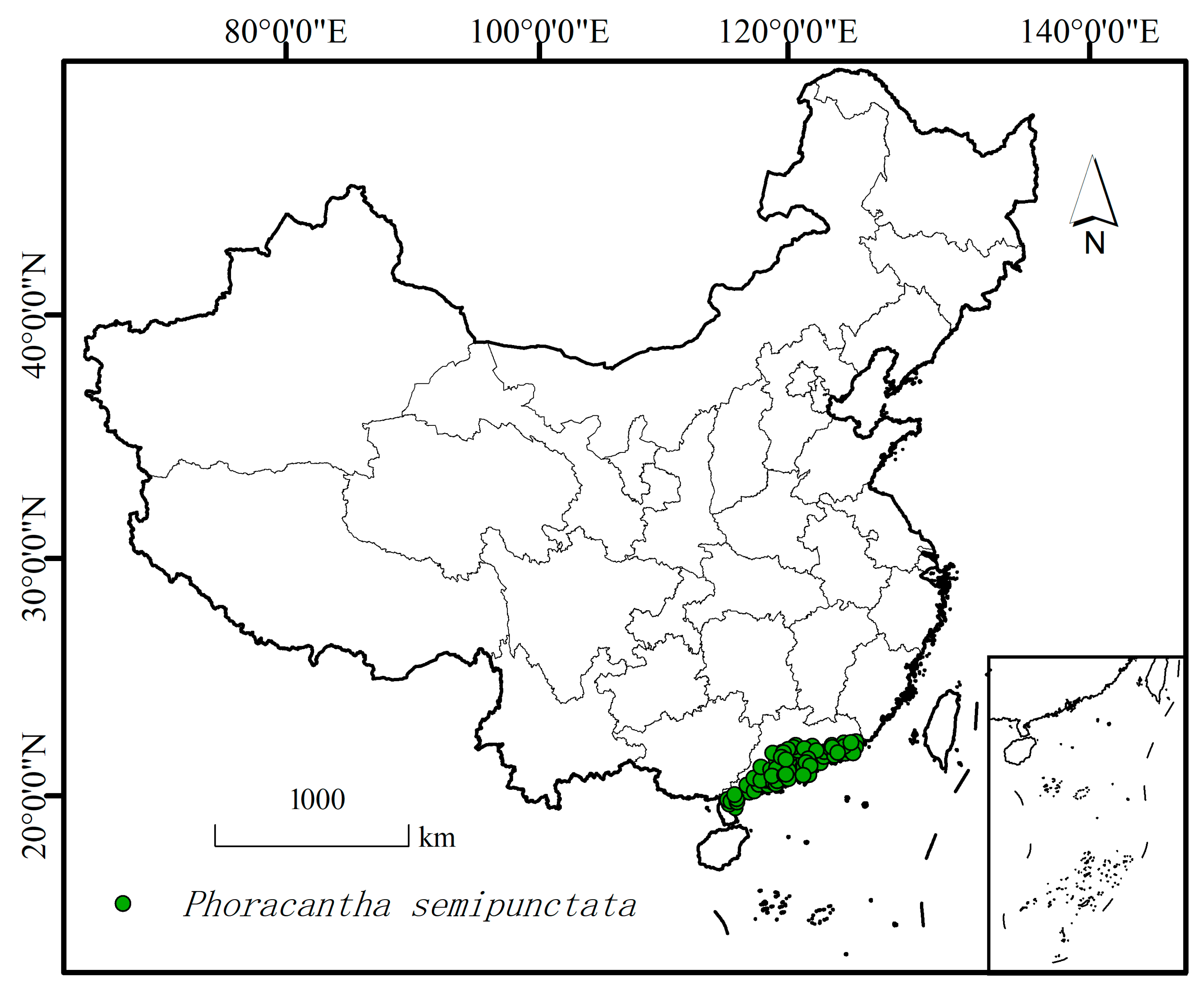
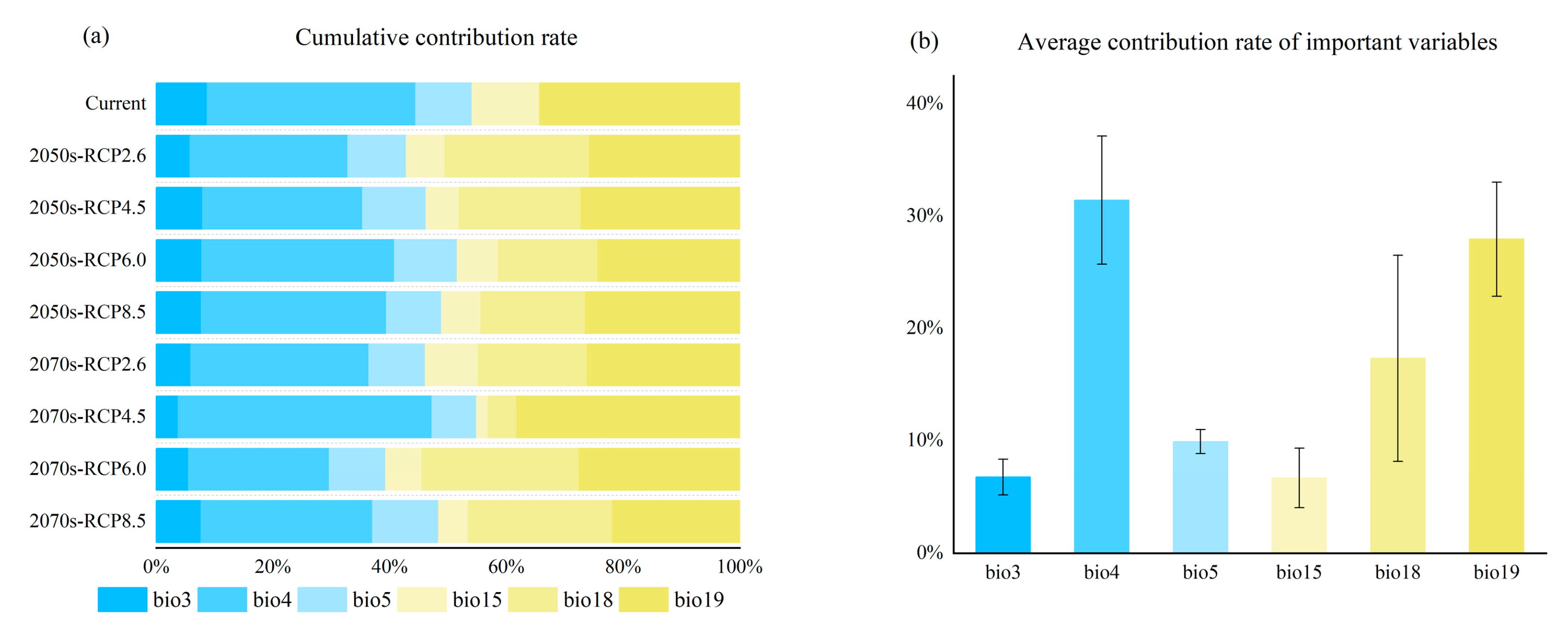

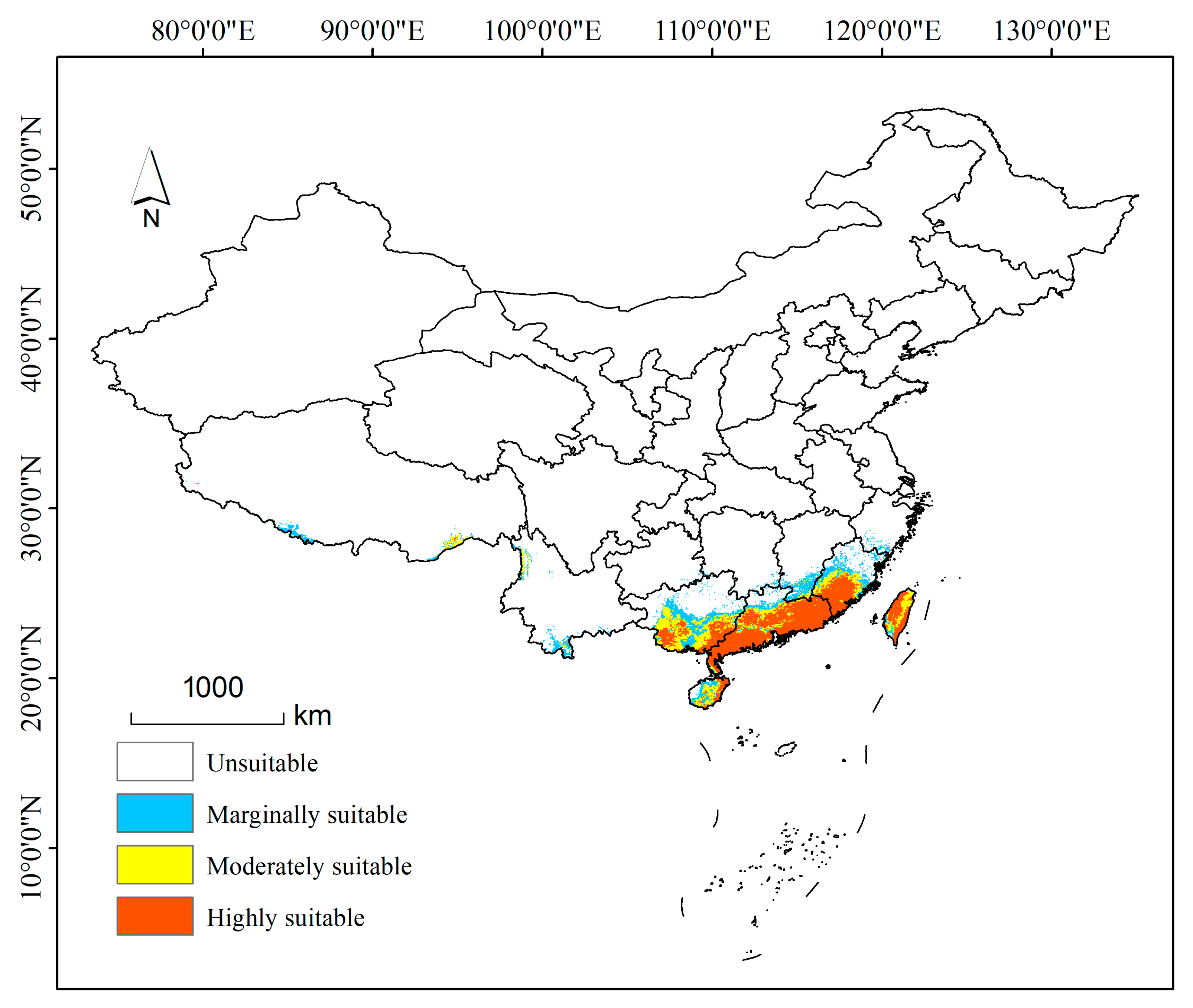
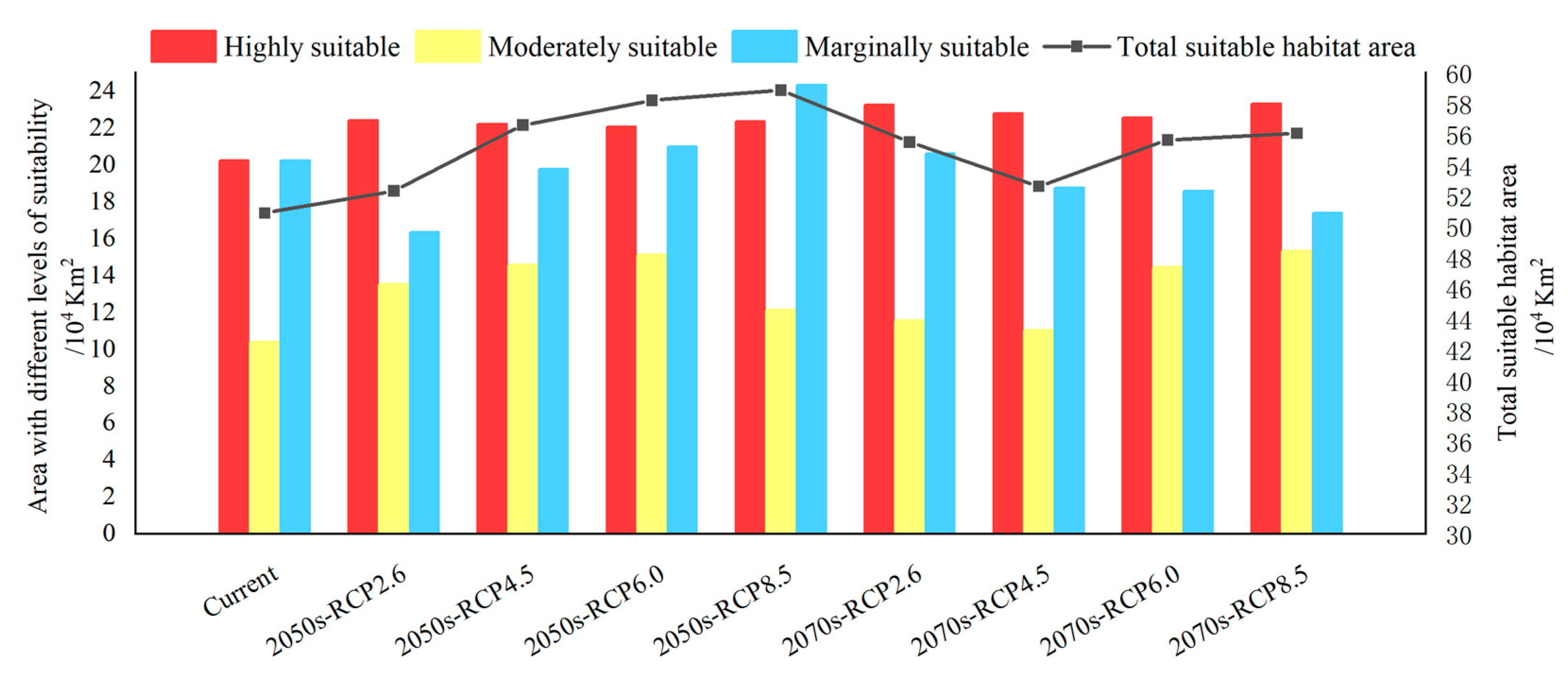
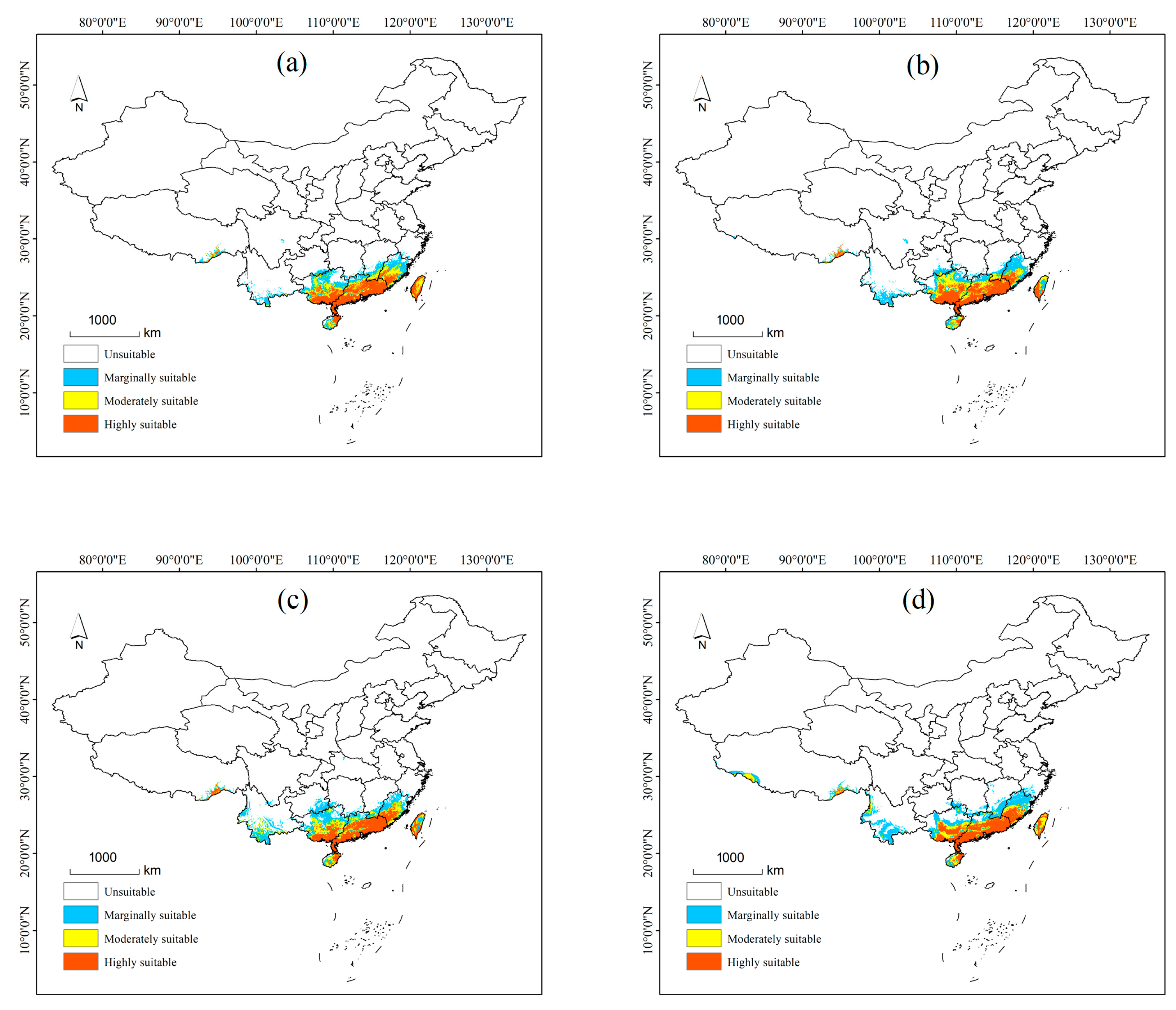
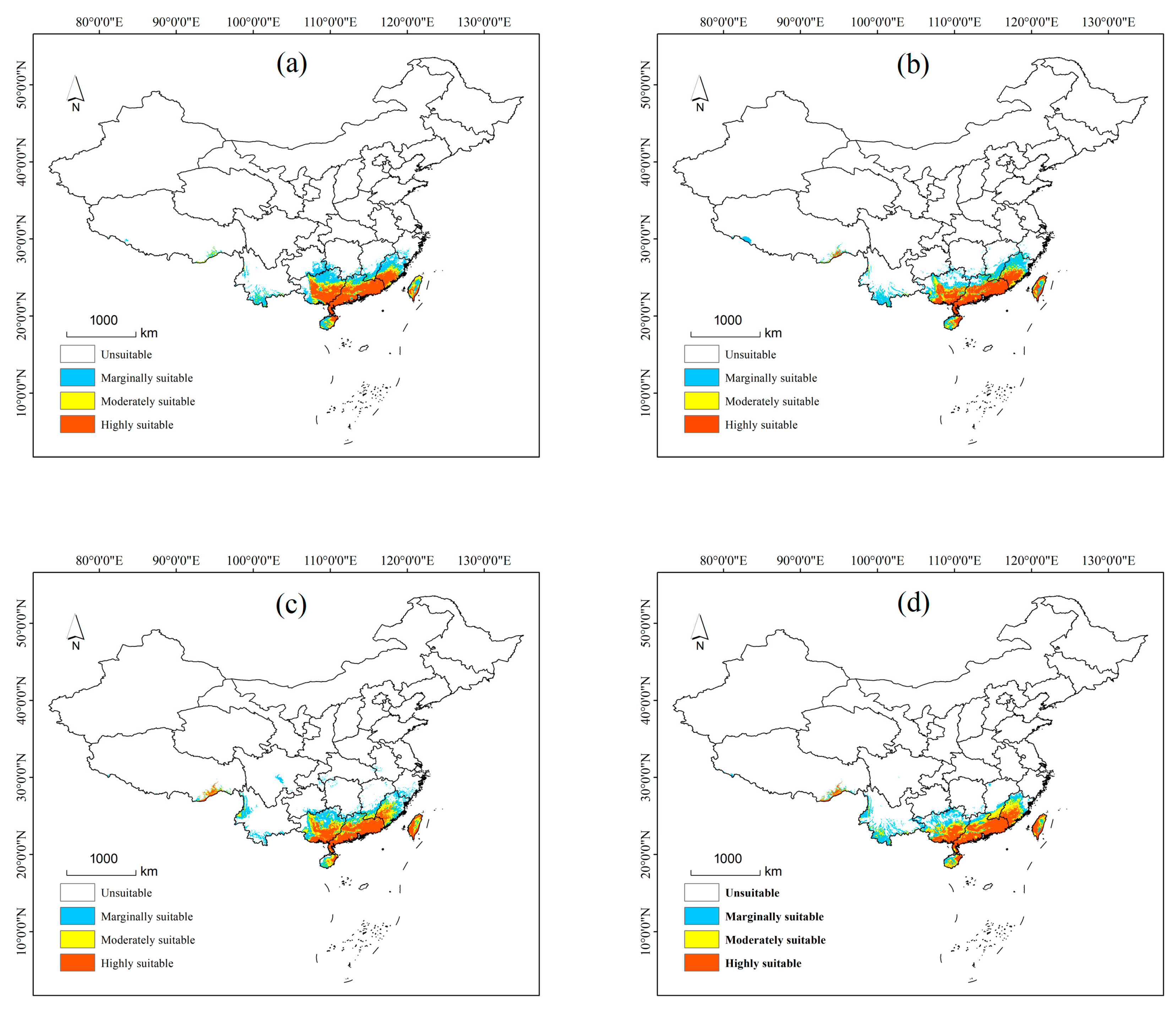
| Data Source | Category | Environmental Variables (Unit) | Abbreviation |
|---|---|---|---|
| WorldClim | Bioclimatic | Annual mean temperature (°C) | Bio1 |
| Mean diurnal range (°C) | Bio2 | ||
| Isothermality (%) | Bio3 | ||
| Temperature seasonality(°C) | Bio4 | ||
| Maximum temperature of warmest month (°C) | Bio5 | ||
| Minimum temperature of coldest month (°C) | Bio6 | ||
| Temperature annual range (°C) | Bio7 | ||
| Mean temperature of wettest quarter (°C) | Bio8 | ||
| Mean temperature of driest quarter (°C) | Bio9 | ||
| Mean temperature of warmest quarter (°C) | Bio10 | ||
| Mean temperature of coldest quarter (°C) | Bio11 | ||
| Annual precipitation (mm) | Bio12 | ||
| Precipitation of wettest month (mm) | Bio13 | ||
| Precipitation of driest month (mm) | Bio14 | ||
| Precipitation seasonality | Bio15 | ||
| Precipitation of wettest quarter (mm) | Bio16 | ||
| Precipitation of driest quarter (mm) | Bio17 | ||
| Precipitation of warmest quarter (mm) | Bio18 | ||
| Precipitation of coldest quarter (mm) | Bio19 | ||
| Geospatial data cloud | Terrain | Altitude (m) | Alt. |
| Aspect (degree) | Asp. | ||
| Slope (degree) | Slop. |
| Index | Extremely High | Very High | High | Average | Fail |
|---|---|---|---|---|---|
| AUC | 1.0–0.9 | 0.9–0.8 | 0.8–0.7 | 0.7–0.6 | 0.6–0.5 |
| Kappa | 1.0–0.85 | 0.85–0.74 | 0.74–0.65 | 0.65–0.5 | <0.5 |
| TSS | 1.0–0.81 | 0.81–0.74 | 0.74–0.61 | 0.61–0.5 | <0.5 |
| Environmental Variables | Min. | Max. | Mean | SD | 5% | 10% | 50% | 90% | 95% |
|---|---|---|---|---|---|---|---|---|---|
| Annual mean temperature (°C) | 18.9 | 23.8 | 22.1 | 0.9 | 18.9 | 19.1 | 22.3 | 23.8 | 23.8 |
| Mean diurnal range (°C) | 7.1 | 7.6 | 7.3 | 0.1 | 7.1 | 7.1 | 7.3 | 7.5 | 7.5 |
| Isothermality (%) | 25.1 | 25.8 | 25.4 | 0.3 | 25.1 | 25.1 | 25.3 | 25.7 | 25.8 |
| Temperature seasonality(°C) | 755.7 | 805.4 | 765.5 | 8.9 | 755.7 | 755.7 | 761.8 | 775.3 | 775.9 |
| Maximum temperature of warmest month (°C) | 31.9 | 35.1 | 32.8 | 1.1 | 31.9 | 32.1 | 32.7 | 34.3 | 35.1 |
| Minimum temperature of coldest month (°C) | −6.5 | 8.2 | 6.7 | 5.6 | −6.5 | −3.8 | 6.2 | 7.5 | 8.2 |
| Temperature annual range (°C) | 28.4 | 30 | 28.8 | 0.3 | 28.4 | 28.4 | 28.7 | 29.2 | 29.3 |
| Mean temperature of wettest quarter (°C) | 27.9 | 29.6 | 28.5 | 1 | 27.9 | 28.1 | 28.5 | 29.1 | 29.6 |
| Mean temperature of driest quarter (°C) | 13.1 | 17.2 | 15.4 | 0.8 | 13.2 | 14.1 | 15.2 | 16.7 | 17.2 |
| Mean temperature of warmest quarter (°C) | 27.9 | 29.6 | 28.5 | 1 | 27.9 | 28.1 | 28.5 | 29.1 | 29.6 |
| Mean temperature of coldest quarter (°C) | 13.1 | 17.2 | 15.4 | 0.8 | 13.2 | 14.1 | 15.2 | 16.7 | 17.2 |
| Annual precipitation (mm) | 912 | 1010 | 977.8 | 24.5 | 944 | 946 | 974.5 | 1010 | 1010 |
| Precipitation of wettest month (mm) | 165 | 182 | 176.2 | 4.4 | 170 | 170 | 175.5 | 182 | 182 |
| Precipitation of driest month (mm) | 8 | 10 | 9.4 | 0.5 | 9 | 9 | 9 | 10 | 10 |
| Precipitation seasonality | 76.9 | 78.2 | 77.4 | 0.4 | 76.9 | 76.9 | 77.3 | 77.8 | 78 |
| Precipitation of wettest quarter (mm) | 475 | 519 | 504.9 | 10.6 | 490 | 491 | 503.5 | 519 | 519 |
| Precipitation of driest quarter (mm) | 29 | 35 | 33 | 1.7 | 31 | 31 | 32.5 | 35 | 35 |
| Precipitation of warmest quarter (mm) | 415 | 469 | 452.5 | 12.2 | 436 | 437 | 451 | 469 | 469 |
| Precipitation of coldest quarter (mm) | 29 | 35 | 33 | 1.7 | 31 | 31 | 32.5 | 35 | 35 |
Disclaimer/Publisher’s Note: The statements, opinions and data contained in all publications are solely those of the individual author(s) and contributor(s) and not of MDPI and/or the editor(s). MDPI and/or the editor(s) disclaim responsibility for any injury to people or property resulting from any ideas, methods, instructions or products referred to in the content. |
© 2025 by the authors. Licensee MDPI, Basel, Switzerland. This article is an open access article distributed under the terms and conditions of the Creative Commons Attribution (CC BY) license (https://creativecommons.org/licenses/by/4.0/).
Share and Cite
Xiao, K.; Deng, R.; Chen, X.; Yu, C.; Wu, L.; Ning, H.; Chen, H. Projection of the Climate-Suitable Area of the Invasive Pest Phoracantha semipunctata (Coleoptera: Cerambycidae: Phoracantha) and Its Ability to Continue to Expand in China. Insects 2025, 16, 1171. https://doi.org/10.3390/insects16111171
Xiao K, Deng R, Chen X, Yu C, Wu L, Ning H, Chen H. Projection of the Climate-Suitable Area of the Invasive Pest Phoracantha semipunctata (Coleoptera: Cerambycidae: Phoracantha) and Its Ability to Continue to Expand in China. Insects. 2025; 16(11):1171. https://doi.org/10.3390/insects16111171
Chicago/Turabian StyleXiao, Kaitong, Ruixiong Deng, Xin Chen, Ciai Yu, Lin Wu, Hang Ning, and Hui Chen. 2025. "Projection of the Climate-Suitable Area of the Invasive Pest Phoracantha semipunctata (Coleoptera: Cerambycidae: Phoracantha) and Its Ability to Continue to Expand in China" Insects 16, no. 11: 1171. https://doi.org/10.3390/insects16111171
APA StyleXiao, K., Deng, R., Chen, X., Yu, C., Wu, L., Ning, H., & Chen, H. (2025). Projection of the Climate-Suitable Area of the Invasive Pest Phoracantha semipunctata (Coleoptera: Cerambycidae: Phoracantha) and Its Ability to Continue to Expand in China. Insects, 16(11), 1171. https://doi.org/10.3390/insects16111171





